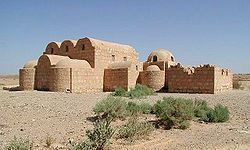Museums
Jordan has a diverse and growing number of museums which serve Jordanian and international visitors alike. Several museums in the capital, Amman, are listed by the Ministry of Tourism and Antiquities. [5] They include the Jordan Museum, which is a national museum focused on Jordan's archaeological and cultural heritage, the Royal Tank Museum housing over 120 tanks with a focus on Jordan's military history, and The Royal Automobile Museum and the Children's Museum Jordan which are both located in King Hussein Park in Amman. There are several art museums and institutions including Darat al Funun, the Jordan National Gallery of Fine Arts and the MMAG Foundation. Other smaller museums in Amman include the Jordan Archaeological Museum on the Amman Citadel, which houses many important archaeological artifacts. The Jordan Folklore Museum also known as the Jordanian Museum of Popular Traditions, is located at the Roman Theater in Amman. The Tiraz Center in Amman focuses on private collections of Palestinian, Jordanian and Arab costumes and textiles. The Museums of Archaeology and Heritage can be found at the campus of the University of Jordan, and require a prior appointment to visit. The Museum of Parliamentary Life and the Ahli Bank Numismatic Museum can also be found in Amman.
Outside of Amman, there are a number of museums focusing on art, archaeology, ethnography and natural history. Overlooking the Baqa'a Valley just north of Amman is the Sami Hindiyeh Art Gallery (opened 2017) with its extensive modern art collection from across the Arab world. In the historic city of as-Salt, there is the Abu Jaber Museum, which focuses on late Ottoman and early 20th century history and traditions, as well as an historic house containing the as-Salt Archaeological Museum. There are numerous agritourism developments in the verdant north of Jordan near Salt, such as the ones in and around the archaeologically rich village of Gilead, namely the Mountain Breeze Resort and those affiliated with BookAgri, which aims to encourage the local farmers to showcase their traditional way of life to visitors. In Madaba, south of Amman, there is the Madaba Archaeological Museum, an Interpretive Center at St. George's Church, home of the Madaba Map, as well as a small museum at nearby Mount Nebo. The Dead Sea Panorama Complex contains an informative museum focusing on the natural history and geology of the Dead Sea. Nearby in Ghor es-Safi is the Lowest Point on Earth Museum, which displays important archaeological discoveries from this region of the South Jordan Valley. The Petra Museum (opened 2019), is located at the entrance of the World Heritage Site of Petra and presents around 300 objects from the Petra region, ranging from prehistory to the present day. [6]
There are several smaller regional or site museums focused on archaeology found across Jordan including the Dar as-Saraya Museum, Irbid, the Museum of Jordanian Heritage at Yarmouk University, also in Irbid, the Karak Archaeological Museum, Karak, the Jerash Archaeological Museum and Jerash Visitor Center, as well as museums at Umm Qais, Aqaba, and Qasr al-Hallabat.
Nightlife
Jordan, most specifically Amman and to a lesser extent Aqaba, has emerged as one of the region's hotspots for nightlife. Alongside Ramallah, Haifa, Dubai, Beirut, Sharm el Sheikh, and Manama, Amman is a premier clubbing destination in the Arab World and the Middle East. [7] The country has seen an explosion in nightlife options ranging from high end nightclubs and bars in the capital city to world-class raves at the Dead Sea and Wadi Rum. Aqaba too has seen a proliferation in nightclubs and beach clubs as a result of the massive of foreign investment and influx of foreign labor and tourists due to the establishment of the special economic zone, ASEZA. Distant Heat held annually in Wadi Rum is considered one of the world's top raves.












